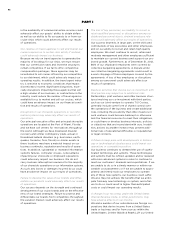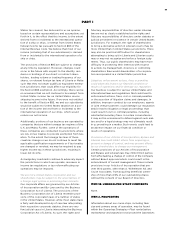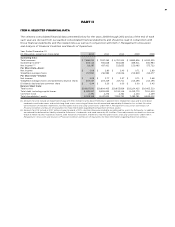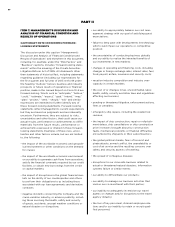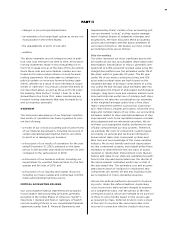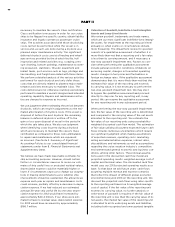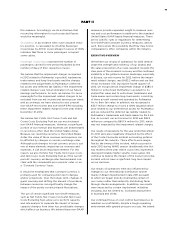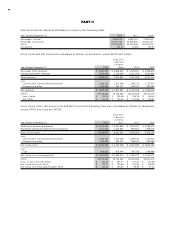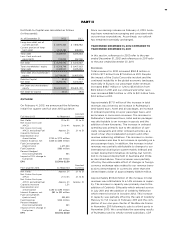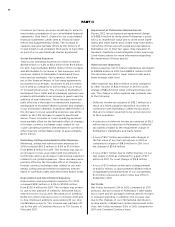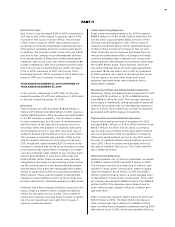Royal Caribbean Cruise Lines 2012 Annual Report Download - page 45
Download and view the complete annual report
Please find page 45 of the 2012 Royal Caribbean Cruise Lines annual report below. You can navigate through the pages in the report by either clicking on the pages listed below, or by using the keyword search tool below to find specific information within the annual report.
41
PART II
and intangible assets, based on their fair value. If nec-
essary, goodwill is then written down to its implied
fair value.
The impairment review for indefinite-life intangible
assets consists of a comparison of the fair value of the
asset with its carrying amount. We estimate the fair
value of our indefinite-life intangible assets, which
consist of trademarks and trade names related to
Pullmantur, using a discounted cash flow model and
the relief-from-royalty method. The royalty rate used
is based on comparable royalty agreements in the
tourism and hospitality industry. The discount rate
used is comparable to the rate used in valuing the
Pullmantur reporting unit in our goodwill impairment
test. If the carrying amount exceeds its fair value, an
impairment loss is recognized in an amount equal
to that excess. If the fair value exceeds its carrying
amount, the indefinite-life intangible asset is not con-
sidered impaired. Other intangible assets assigned
finite useful lives are amortized on a straight-line basis
over their estimated useful lives.
The factors influencing expected future cash flows for
purposes of goodwill impairment testing discussed
above also affect the assessment of recoverability of
Pullmantur’s deferred tax assets. Pullmantur’s deferred
tax assets principally result from net operating loss
carryforwards. We regularly review deferred tax assets
for recoverability based on our history of earnings,
expectations of future earnings, and tax planning
strategies. Realization of deferred tax assets ultimately
depends on the existence of sufficient taxable income
to support the amount of deferred tax assets. A valu-
ation allowance is recorded in those circumstances
in which we conclude it is not more-likely-than-not
we will recover the deferred tax assets prior to their
expiration.
We review our ships, aircraft and other long-lived
assets for impairment whenever events or changes
in circumstances indicate, based on estimated undis-
counted future cash flows, that the carrying amount
of these assets may not be fully recoverable. We eval-
uate asset impairment at the lowest level for which
identifiable cash flows are largely independent of the
cash flows of other assets and liabilities. The lowest
level for which we maintain identifiable cash flows
that are independent of the cash flows of other assets
and liabilities is at the ship level for our ships and at
the aggregated asset group level for our aircraft. (See
Note 2. Summary of Significant Accounting Policies
to our consolidated financial statements under Item 8.
Financial Statements and Supplementary Data). If esti-
mated future cash flows are less than the carrying
value of an asset, an impairment charge is recognized
for the difference between the asset’s estimated fair
value and its carrying value.
We estimate fair value based on quoted market prices
in active markets, if available. If active markets are not
available we base fair value on independent apprais-
als, sales price negotiations and projected future cash
flows discounted at a rate estimated by management
to be commensurate with the business risk. Quoted
market prices are often not available for individual
reporting units and for indefinite-life intangible assets.
Accordingly, we estimate the fair value of a reporting
unit and an indefinite-life intangible asset using an
expected present value technique.
Impairment of Pullmantur related assets
During the fourth quarter of 2012, we performed our
annual impairment review of goodwill for Pullmantur’s
reporting unit. We did not perform a qualitative
assessment but instead proceeded directly to the
two-step goodwill impairment test. Pullmantur is a
brand targeted primarily at the Spanish, Portuguese
and Latin American markets and although Pullmantur
has diversified its passenger sourcing over the past
few years, Spain still represents Pullmantur’s largest
market. As previously disclosed, European economies
continued to demonstrate instability in light of height-
ened concerns over sovereign debt issues as well as
the impact of proposed austerity measures on certain
markets. The Spanish economy was more severely
impacted than many other economies and there is
significant uncertainty as to when it will recover. In
addition, the impact of the Costa Concordia incident
has had a more lingering effect than expected and
the impact in future years is uncertain. These factors
were identified in the past as significant risks which
could lead to the impairment of Pullmantur’s goodwill.
The Spanish economy has progressively worsened
and forecasts suggest the challenging operating
environment will continue for an extended period of
time. The unemployment rate in Spain reached 26%
during the fourth quarter of 2012 and is expected to
rise further in 2013. The International Monetary Fund,
which had projected GDP growth of 1.8% a year ago,
revised its 2013 GDP projections downward for Spain
to a contraction of 1.3% during the fourth quarter of
2012 and further reduced it to a contraction of 1.5%
in January of 2013. During the latter half of 2012
new austerity measures, such as increases to the
Value Added Tax, cuts to benefits, the phasing out
of exemptions and the suspension of government
bonuses, were implemented by the Spanish govern-
ment. We believe these austerity measures are having
a larger impact on consumer confidence and discre-
tionary spending than previously anticipated. As a
result, there has been a significant deterioration in
bookings from guests sourced from Spain during the
2013 WAVE season. The combination of all of these
factors has caused us to negatively adjust our cash
flow projections, especially our closer-in Net Yield



